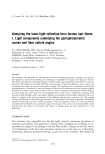LIGHT REFLECTION FROM HAIR 307 GP CURVE ANALYSIS Figure 2 shows the raw data for the scattering profile of a dark brown, female, Caucasian hair near its root end. The data points show pronounced scattering due to the speckle effect, which results from the laser being a coherent monochromatic light source (1). To suppress the data scatter, moving average smoothing was found to be adequate, yielding the solid line in Figure 2, which is taken as the GP curve. The higher initial smoothness of scattering curves shown in the literature (e.g., 1,2,9) is attributed to the lower resolution of goniophotometric devices, the suppression of the speckle effect by the use of a white light source, and the testing of hair collectives. Figure 5 shows the GP curve for a virtually black Asian hair. By fitting Gaussian peaks to the curves, as described below, it is shown that the curve prominently features a strong peak at a receptor angle of 36 ø and a width at half height of 9 ø. This peak is attributed to specular reflection. With equation 1 the location of this peak yields the tilt angle for the cuticle cells. The underlying, low-intensity, broad peak derives from diffuse reflection effects. Figure 6 shows the GP curve of a medium brown hair, similar to the one for Figure 2, but measured at about 30 cm from the root. The curve shows a similar peak for specular reflection as the Asian hair, but superimposed on a broad background peak for Ds, that is, for diffuse scattering. Due to the lighter color of the hair closer to the tip compared to a position near its root end, a substantial fraction of the light enters the fiber, where it is not completely absorbed, but re-emerges in a diffuse manner. The D s intensity shows a pronounced angular dependence with a directional preference of around 50 ø. Figure 7 shows the GP curve for a light blonde hair, originating from the tip region of a light brown hair. The curve features the strong and narrow specular peak, superim- posed on the strong, underlying intensity distribution of diffuse reflectance. A further peak is observed at 65 ø, which is attributed to D i, that is, to internally reflected light. The angle-dependent intensities of specularly (S), diffusely (D,), and internally (Di) 0,6 'E 0,5 • 0,4 ._• 0,3 = 0,2 -= 0,4 0,0 --- ' ................................... 0 10 20 30 40 50 60 70 80 90 Receptor Angle [ø] Figure 5. GP curve data (--) for a black Asian hair about 5 cm from its root end. Distributions for specularly (----) and diffusely (---) reflected light, as fitted to the GP curve.
308 JOURNAL OF COSMETIC SCIENCE 0,015 •' 0,010 . - • 0,005 • •.. - __••••,• 0,000 , 0 10 20 30 40 50 60 70 80 90 Receptor Angle [ø] Figure 6. GP curve data (--) for a medium brown hair measured at a position of about 30 cm from the root. Distributions for specularly ( .... ) and diffusely (---) reflected light, as fitted to the GP curve. 0 10 20 30 40 50 60 70 80 90 Receptor Angle [ø] Figure 7. GP curve data (--) for a light blonde hair measured at a position near the tip end. Distributions for specularly ( .... ), diffusely (---), and internally (---) reflected light, as fitted to the GP curve. 0,45 0,40 0,35 0,30 0,25 0,20 0,15 0,10 0,05 0,00 reflected light, respectively, are determined by simultaneously fitting to the GP curve up to three Gaussian distributions, each of which is given by: I = A/[(2'rr)1/20'] exp{-1/2 [(y - p)/cr] 2} (7) where I is the intensity count of a given type of reflected light at a given angle % cr is the standard deviation of the Gaussian distribution, describing its width, and p its mean, signifying the position of the peak maximum. A is a scaling parameter related to the area of the peak. The Gaussian peaks are fitted to the GP curves, applying nonlinear optimization strat- egies implemented in QuattroPro (Corel) and PeakFit (Jandel). The distributions are shown in Figures 5-7. The correlation coefficient, being the appropriate measure for the fraction of explained variance for the individual fits, always well exceeded 0.9. The distributions are descriptions of the horizontal indicatrices (9) for the different fractions of light, reflected from a single hair. The choice of the Gaussian distribution
Purchased for the exclusive use of nofirst nolast (unknown) From: SCC Media Library & Resource Center (library.scconline.org)


























































































